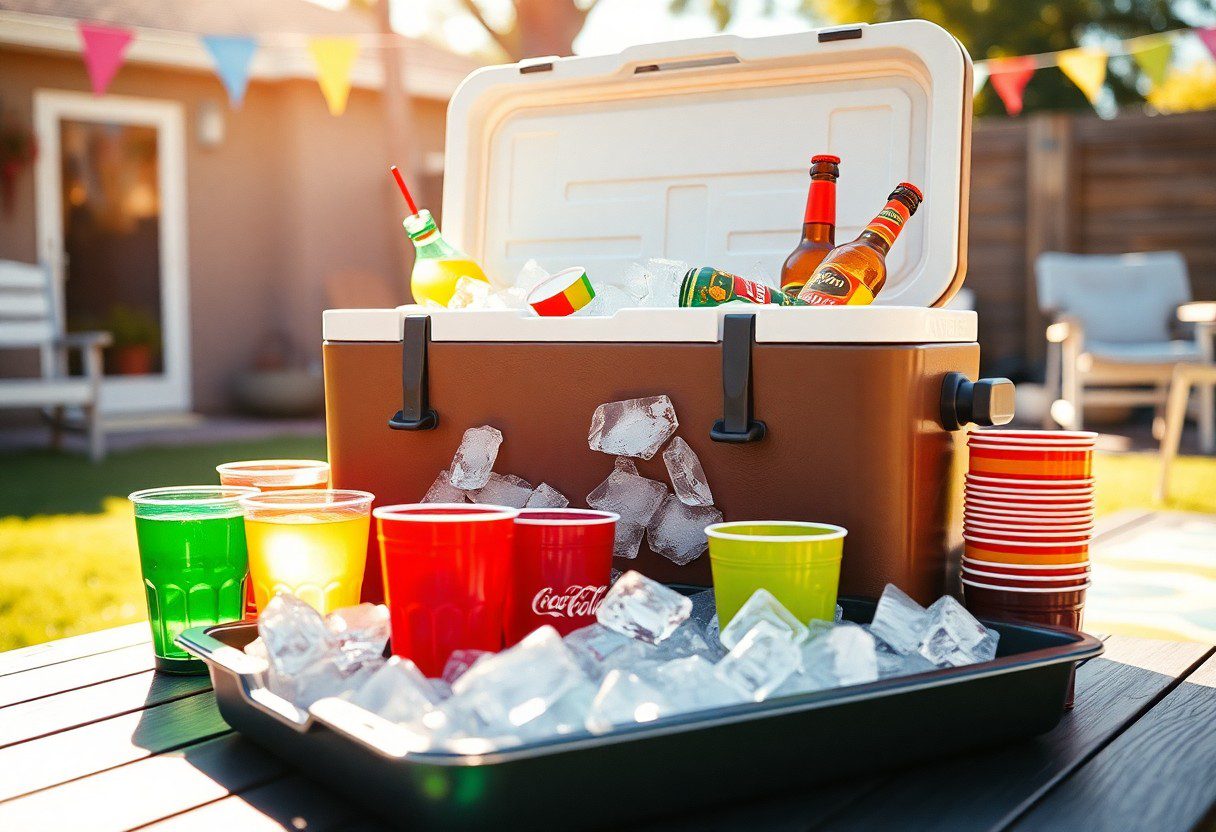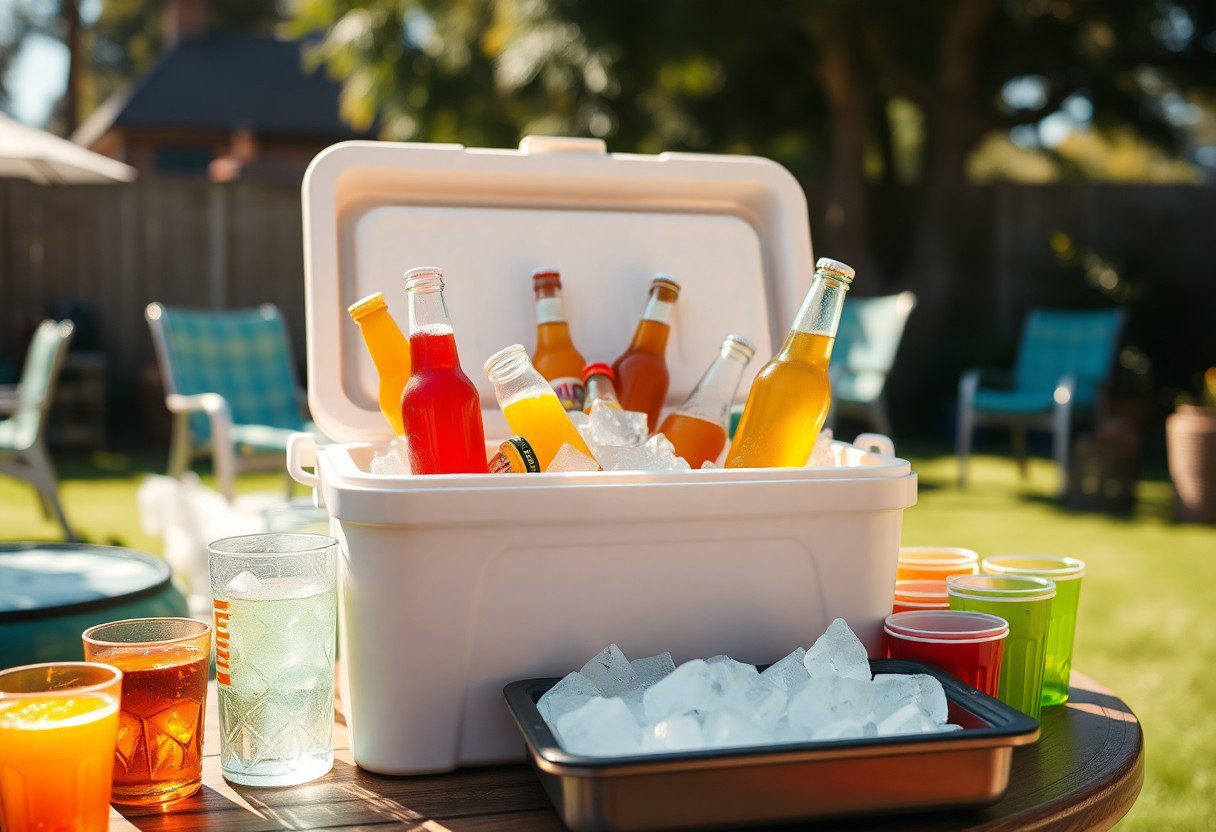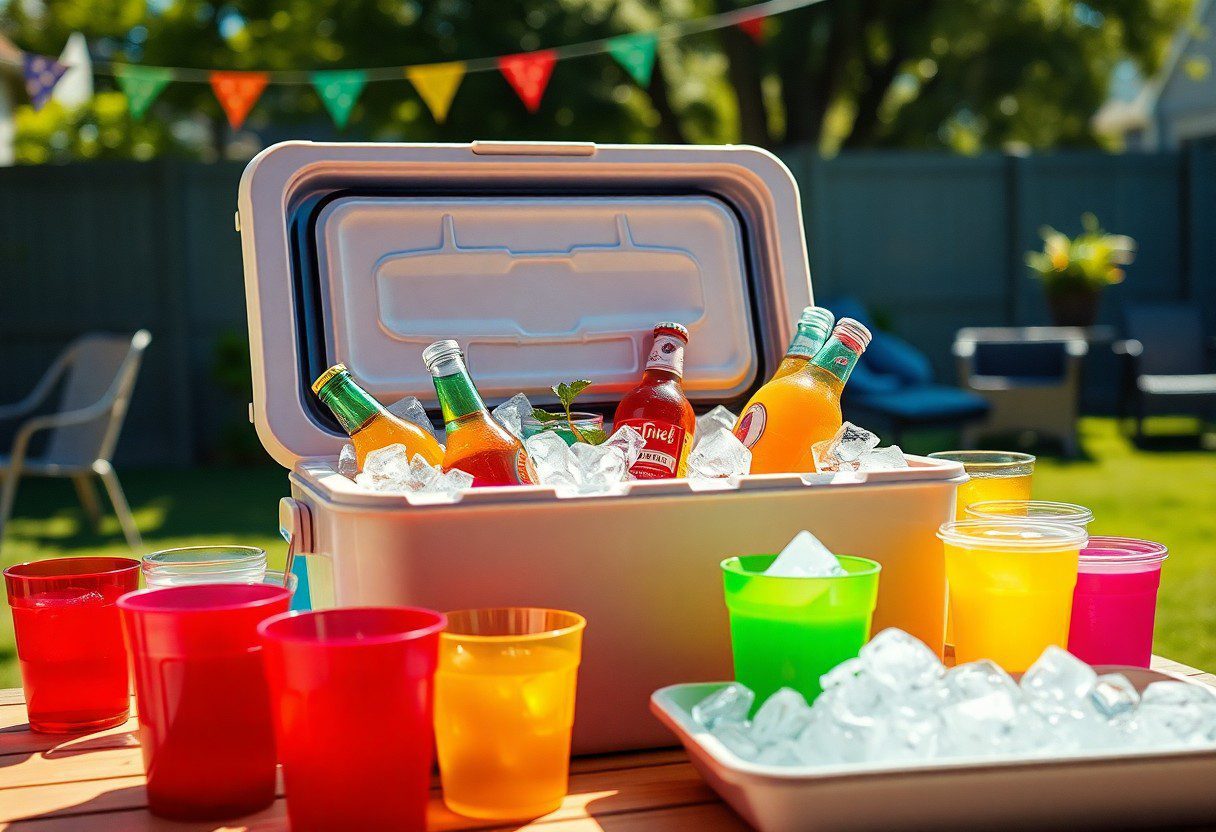Party planning can be a whirlwind of excitement, but ensuring your drinks stay cold is crucial for keeping your guests refreshed. In this guide, you’ll discover practical tips and creative hacks that make it easy to maintain frosty beverages throughout your event. From choosing the right containers to utilizing clever chilling techniques, you’ll learn how to keep your drinks cold and enjoyable for everyone. Follow these straightforward steps to transform your gathering into an unforgettable experience with perfectly chilled refreshments.
The Science of Chill: How Temperature Affects Your Beverages
Understanding the principles of temperature can significantly enhance your beverage experience at any gathering. The chill factor directly impacts flavor, aroma, and overall enjoyment, leading to a more satisfying drink. Colder temperatures suppress unwanted flavors while accentuating the refreshing qualities of your chosen beverages, keeping them appealing to your guests.
Temperature Effects on Beverages
| Temperature Range | Drink Flavor Profile |
|---|---|
| 32°F – 38°F | Bright and refreshing flavors emerge. |
| 39°F – 45°F | Subtle notes are more detectable, suitable for wines. |
| 46°F – 55°F | Complex flavors shine, but can lose refreshing qualities. |
| Above 56°F | Flavors can become dull and flat. |
The Ideal Serving Temperature for Drinks
Serving your drinks at the right temperature can elevate the overall experience. For example, lagers and pilsners are best enjoyed between 38°F and 42°F, while red wines reveal their complexity best around 55°F. Knowing these temperature ranges can help you serve drinks that taste exactly how they were intended.
Ideal Serving Temperatures
| Type of Beverage | Ideal Temperature (°F) |
|---|---|
| Draft Beer | 38-42 |
| White Wine | 45-50 |
| Red Wine | 55-60 |
| Cocktails | Ice-cold (around 32) |
How Heat Transfer Works in a Party Environment
During a party, heat exchange is constant and happens between drinks, ice, and the surrounding environment. As you serve drinks, warmer air and body heat transfer to the cold beverages, affecting their temperature. Ice melts, absorbing heat and providing brief relief, yet this yields diminishing returns over time. You might notice that drinks can quickly become tepid unless you employ strategies to maintain their chill.
Continuing to monitor the surrounding temperature and adjusting your cooling methods accordingly is imperative. For example, keeping drinks in ice buckets rather than on tables prevents faster warming from body heat. Layering ice and water in your drink containers enhances heat exchange efficiency, allowing you to keep your beverages cold throughout the entire event.
Creative Cooling Solutions: Beyond the Standard Ice Bucket
Explore innovative methods to keep your drinks perfectly chilled without relying solely on traditional ice buckets. By integrating creativity and functionality, you can enhance your party experience, ensuring drinks are enjoyable from the first sip to the last. Think outside the box—consider fun, unique solutions that not only serve a practical purpose but also add a visually appealing touch to your gathering.
Innovative Ice Alternatives You Should Consider
Get creative with alternatives to ice that will keep your drinks cold without the watery mess. Frozen fruit, like grapes or berries, not only prevents dilution but also adds a splash of flavor to your beverages. Ice cubes made from herbal teas or citrus juices can enhance your cocktails while keeping them cool. Another fun option is using large blocks of ice in a punch bowl—slowly melting, they maintain the drink’s chill without overwhelming it with excess water.
Utilizing Natural Refrigerants for an Eco-Friendly Party
Embracing natural refrigerants can be a simple way to keep your drinks chilled while being kind to the planet. Reusable gel packs, made from water and non-toxic materials, trap cold temperatures for hours and can be refrozen for repeated use. Organic, biodegradable ice substitutes, such as frozen bags of water or gel-filled cooler cubes, ensure that you’re not contributing to single-use plastics at your event. Invest in this sustainable approach to cooling, and your party will not only be fun but also eco-conscious.
Utilizing natural refrigerants like reusable gel packs or biodegradable ice bags strikes a balance between functionality and environmental responsibility. These alternatives excel in maintaining cold temperatures without the mess typical of traditional ice. From gel-filled cooler cubes that offer long-lasting chill to creative uses of frozen water bags, you can implement these solutions to minimize waste. Not only will your drinks remain refreshingly cold, but your guests will appreciate the thoughtful approach to sustainable partying, making your gathering both enjoyable and eco-friendly.
Strategic Drink Placement: Where to Store for Optimal Coolness
Positioning your drink stations strategically can play a major role in maintaining their chill. Areas with natural shade provide a cooler environment, while placing drinks on a lower shelf can help utilize the cooler air that settles closer to the ground. Additionally, scattering drink stations throughout the venue can reduce congestion and allow guests easy access to refreshments without letting them warm up excessively.
Best Locations for Beverage Stations
Set up your beverage stations in shaded areas whenever possible, avoiding direct sunlight to keep drinks colder for longer. Creating stations near food zones also encourages guests to stay in those cooler spots, blending convenience with optimal drink temperature. Make use of existing natural elements like trees or large umbrellas for added shade.
The Influence of Sunlight and Ambient Temperature
Sunlight can dramatically affect the temperature of your beverages, which is why understanding its impact is imperative. Keeping sunny areas at bay not only preserves the coolness but also saves you from constantly replenishing ice supplies. Additionally, if the surrounding temperature is high, it can heat drinks quickly; therefore, the right placement in cooler parts of your venue can make all the difference.
Impact of Sunlight on Beverage Temperature
| Factor | Influence on Temperature |
|---|---|
| Direct Sunlight | Increases temperature rapidly, often by 10-15°F within an hour. |
| Shade | Helps maintain a temperature closer to the ambient air, extending chill time. |
Exposing beverages to sunlight can lead to significant warmth. For example, drinks left in direct sunlight can reach uncomfortable temperatures very quickly, rendering them less refreshing. On the other hand, shaded areas can retain a more favorable temperature, so consider using tents or natural landscapes to mitigate exposure during summertime gatherings. Elevating shaded beverage stations above hot ground surfaces likewise proves beneficial.
Optimal Locations for Beverage Chill
| Location Type | Chill Enhancement |
|---|---|
| Under Trees | Natural shade maintains lower drink temperatures, increasing refreshment. |
| Indoor Areas | Climate-controlled spaces can keep beverages at ideal temperatures. |
DIY Hacks for Dramatic Drink Cooling
Quick Freezing Techniques to Use Before the Party
To kick off your drink-cooling game before guests arrive, utilize quick-freezing strategies. Place bottles or cans in the freezer for 15-30 minutes for a super-chill effect. For even faster results, wrap a damp paper towel around your beverage containers and pop them in the freezer; the moisture speeds up the cooling process. Just set a timer to avoid forgotten ice cubes that are too frozen for fun.
Building Your Own Portable Cooling Solutions
Creating your own portable cooling solutions provides flexibility and keeps drinks chilled throughout the event. A simple cooler filled with ice and salt accelerates the cooling process, as salt lowers the freezing point of ice, allowing the mixture to get colder than ice alone. You can also modify insulated bags by adding ice packs or even frozen water balloons, which are less messy and provide a unique touch to your drink stations.
For a more advanced approach, consider constructing a simple PVC pipe ice chest. Cut lengths of PVC to hold beverages and fill them with ice; the design allows cold air to circulate all around your drinks, keeping them icy for hours. Another creative option is a galvanized tub filled with ice and decorated to fit your party theme. These options not only serve their purpose but add an interesting element to your gathering while ensuring your beverages remain refreshingly cool.
Enhancing the Experience: The Psychology of Cold Drinks
The temperature of a drink significantly influences your overall experience at a party. Chilled beverages not only refresh but also evoke a sense of enjoyment and satisfaction. The coolness triggers pleasure receptors in your brain, leading to a more relaxed atmosphere. This psychological response ties into your memories and associations with similar experiences, elevating simple sips into celebratory moments. Engaging with cold drinks fosters a playful and social vibe, enhancing the mood and making gatherings more memorable.
The Role of Presentation in Coolness Perception
Your guests are likely to perceive drinks as colder and more appealing if they are served in stylish, frosted glasses or creatively arranged in an eye-catching ice display. The aesthetics play a powerful role in how we experience taste and temperature. Innovative serving methods, such as incorporating fresh fruit garnishes or unique ice cubes infused with herbs, not only enhance the visual appeal but also set the stage for a refreshing experience that draws everyone’s attention.
How Cold Drinks Contribute to Party Atmosphere
Cold drinks serve as social lubricants that break the ice and encourage mingling among guests. As you sip on your chilled beverage, it naturally promotes conversations and interactions, fostering a communal spirit. Studies show that consuming cold drinks can increase feelings of happiness and relaxation, which definitely enhances the overall atmosphere of a party. Providing a variety of icy options can cater to different tastes, ensuring everyone has something to enjoy, and creating an inviting environment.
This communal aspect is fundamental during gatherings, as cold drinks can become the centerpiece around which guests congregate. Imagine a vibrant outdoor BBQ where everyone gathers around the cooler, sharing laughs while reaching for their favorite beverages. The tactile experience of holding a cold can or glass sparks joy and creates a connection among attendees. By offering drinks that refresh the body and invigorate the spirit, you not only enhance individual enjoyment but also contribute to a lively, engaging atmosphere that keeps the party going strong.
To wrap up
As a reminder, keeping drinks cold at your party can be easily achieved with a few simple strategies. Utilize ice buckets, which can be filled with ice and salt for quicker chilling, and consider using insulated coolers to maintain low temperatures. You can also pre-chill your beverages in the refrigerator or freezer before the event. Adding frozen fruit instead of ice not only keeps your drinks cold but enhances their flavor. By applying these tips, you ensure your guests enjoy refreshing beverages throughout your gathering.
FAQ
Q: What are some effective ways to keep drinks cold at a party?
A: To keep drinks cold, consider several methods such as using ice buckets, pre-chilling drinks in the refrigerator, and incorporating frozen fruits instead of ice cubes. Ice buckets filled with ice and salt can help maintain colder temperatures longer, while placing drinks in a shaded area outdoors can prevent them from warming up quickly.
Q: How can I use ice effectively to keep drinks cold?
A: Using ice effectively includes filling a large container or cooler with ice and mixing in some salt, which lowers the melting point of ice and creates a colder environment. You can also use ice packs or gel packs that are specifically designed to stay cold for extended periods. Make sure to add ice just before guests arrive for optimal chill.
Q: What are some creative alternatives to ice for chilling drinks?
A: Some creative alternatives include using frozen towels or wet sponges wrapped around beverage bottles, placing cans in a mixture of saltwater and ice to increase cooling speed, and utilizing blast chillers if available. You can also freeze grapes, berries, or other fruits to use as naturally cold drink stirrers that won’t dilute the beverage.
Q: How can I ensure beer and other drinks stay cold throughout the party?
A: To keep beer and other drinks cool throughout the event, consider placing them in a salted ice bath for quick cooling initially and then transferring them to an insulated cooler. Regularly replenish the ice during the party and arrange for a designated spot to keep drinks shaded and insulated from the sun or heat sources.
Q: What tips can I follow for outdoor parties specifically regarding keeping drinks cool?
A: For outdoor parties, position drink stations in shaded areas away from direct sunlight, use umbrellas or canopies for extra protection, and select insulated coolers to keep the drinks cold. Additionally, consider using dry ice as it lasts longer than regular ice. Organizing drinks in smaller batches can also make it easier to refresh them with cold supplies regularly.





